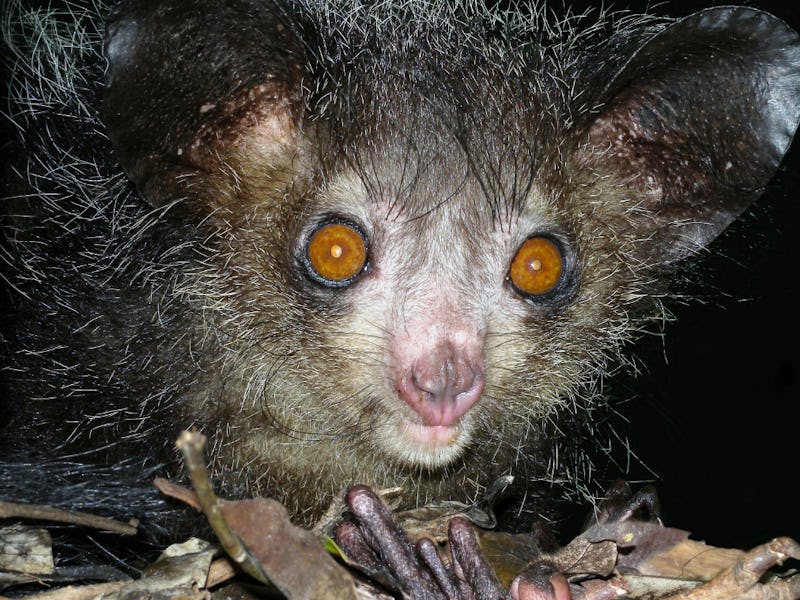Find Halloween Inspiration With These Six Creepy Animals
Forget zombies and go as a aye-aye lemur.

Typically the spooky creatures we associate with Halloween are of the humanistic variety: Anti-heroes like Frankenstein who make us consider our own mortality. But why look to fiction when there’s so much creepiness to appreciate in the world around us? Exhibit A: Animals.
Despite what the Internet may lure you into thinking, there are more animals than dogs, cats, and red pandas. Some scientists believe that there could be a trillion species on Earth — a grouping of land, sea, and eukaryotic species that we’ve barely discovered.
In the group of animals that we do know there’s a fair share that, as innocent as they may be, look poised to star in their own horror movie. Here are some of the slimiest, hairiest, and downright creepy animals on Earth:
The Purple Frog
The purple frog was only discovered in 2003 and has been creeping us out since then. A large frog with a bloated appearance, the purple frog is native to India and the sole member of the Nasikabatriachidae family.
Wow, look at that.
While the breeding habits of the frog are still secretive, scientists believe that the burrowing frog spends most of the year underground. Then for two weeks when monsoon season hits, it comes up and gets down in temporary ponds. It’s a lot like the creature from the Black Lagoon — except a whole lot nicer.
Wolfish
There’s the wolfish that live in the tropical waters of Suriname and then there’s the Atlantic wolfish that swims about off the coast of New England. They’re both big and gnarly. The South American wolfish grow to a maximum diameter of 39 inches and can weigh up to 88 pounds. Their behavior is described as both shy and aggressive (their bites can leave flesh wounds).
The skull of an Atlantic wolffish.
The Atlantic wolffish has a large head with canines and molars that can crush whole clams, scallops, and lobsters. Equipped with long, eel-like tales these guys can live up to 20 years old. Unfortunately, because of commercial fishing they are also very much in danger. Just because they look like monsters, doesn’t mean we should act like a monster to them.
The Lobster Moth
The lobster moth gets its name from how it looks like a caterpillar. When it’s young, its bulbous ridged form looks suspiciously crustacean-like, shooting out formic acid as defense.
The caterpillar looks more like a lobster claw.
When it emerges from its cocoon, it emerges fuzzy and leaf-like. With a wingspan ranging from 40 to 70 millimeters, it’s horror like appearance is reserved for its childhood.
The Aye-Aye Lemur
The appearance of an aye-aye lemur is a long way from Zoboomafo. Described by Duke’s Lemur Center as the “strangest primate in the world” the aye-aye coarse black hair, dark rings around their eyes, and skeletal-looking hands. They also are equipped with middle fingers that are also their primary sensory organs.
The aye-aye's fingertips.
“The aye-aye is the lemur that shouldn’t be,” Duke’s Chris Smith told Pacific Standard. “It doesn’t necessarily act like a lemur, but it ends up being one of the most fascinating primate in Madagascar.”
These nocturnal, solitary animals also tragically bare the brunt of their ugliness. In their native Madagascar they are sometimes beaten to death just because they exist.
The Deep Sea Hatchet Fish
At a terrifying 3-inch length, the deep sea hatchet fish lives in ocean depths of up to 4,000 feet. In the Argyropelecus affini family, these fish have light-producing organs in their bellies that shine a pale blue light. They are abundantly found off the coast of California, Chile, and in the north Indian Ocean.
Hatchetfish regulate the light of their organs to the light around them.
The Marabou Stork
The African Marabou stork is a freaky bird. Bald-headed with red spots, it feeds off decaying flesh and scraps. They also have long, pouches that hang from their necks — an 18-inch sac the inflates during mating seeing so it can better launch a guttural croak.
Cute.
The stork also has a scary preference for hanging out near grass fires so that when animals flee, they can grab them. On the upside, they mate for life — so at least there’s a little romance left in the horror.